Which of the following statement(s) is/are not correct?
- Cork cambium is also called phellogen.
- Cork is also called phellem.
- Secondary cortex is also called periderm.
- Cork cambium, cork and secondary cortex are collectively called phelloderm.
(iii) and (iv)
(i) and (ii)
(ii) and (iii)
(ii) and (iv)
Correct Answer :
A. (iii) and (iv)
Secondary cortex is also called phelloderm cork cambium, cork and secondary cortex are collectively called periderm.
Related Questions
Tissues are classified into two main groups, namely meristematic and permanent tissues on the basis of
whether the cells being able to divide or not.
position of the cells.
whether they are living or dead.
none of the above
During the formation of leaves and elongation of stem, some cells left behind from the shoot apical meristem, constitute the
lateral meristem
axillary bud
cork cambium
fascicular cambium
One of the primary function of the ground tissue in a plant is
photosynthesis.
to protect the plant.
to anchor the plant.
water and sugar conduction.
Trees at sea do not have annual rings because
soil is sandy.
there is climatic variation.
there is no marked climatic variation.
there is enough moisture in the atmosphere.
Which of the following statements are correct ?
- Xylem transports water and minerals.
- Gymnosperms lack sieve tubes and companion cells in phloem.
- The first formed primary xylem is called metaxylem.
- Phloem fibres (bast fibres) are made up of collenchymatous cells.
(i) and (iii)
(i) and (ii)
(iii) and (iv)
(i) and (iv)
A student was given a tissue to observe under the microscope. He observes the tissue and concludes that the tissue is a type of simple plant tissue and provides mechanical support to young stem and petiole of leaf.
Identify the tissue.
Parenchyma
Collenchyma
Sclerenchyma
Xylem parenchyma
Which of the following figure is a type of permanent tissue having many different types of cell?
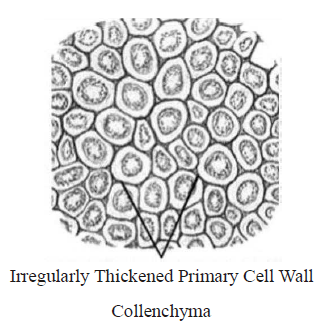
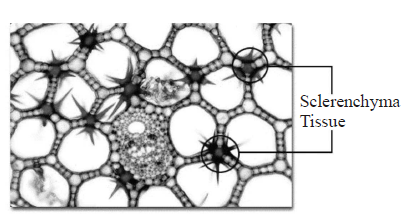
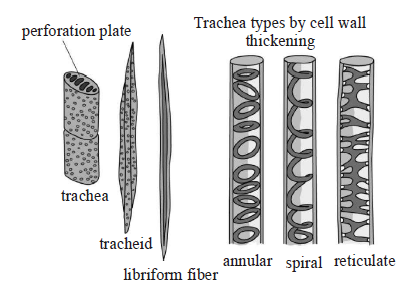
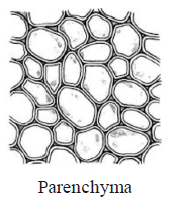
In stems, the protoxylem lies towards the _____________ and the metaxylem lies towards the ____________ of the organ.
centre; periphery
periphery; centre
periphery; periphery
centre; centre
A plant tissue when stained showed the presence of hemicellulose and pectin in cells wall of its cells. The tissue is called
collenchyma
sclerenchyma
xylem
meristem
Choose the correct labelling of (A J) in the given figure of T.S. of monocot root.

A Root hair, B Epiblema, C Cortex, D Endodermis, E Passage cell, F Pericycle, G Pith, H Phloem, I Metaxylem.
A Root hair, B Epiblema, C Cortex, D Endodermis, E Passage cell, F Pith, G Pericycle, H Metaxylem, I Phloem.
A Root hair, B Epiblema, C Cortex, D Endodermis, E Pericycle, F Phloem, G Protoxylem, I Metaxylem
A Root hair, B Cortex, C Epiblema, D Pericycle, E Endodermis, F Pith, G Phloem, H Protoxylem, I Metaxylem
Which one of the following option shows the correct labelling of the parts marked as A, B, C and D in the given figure of a typical dicot root?
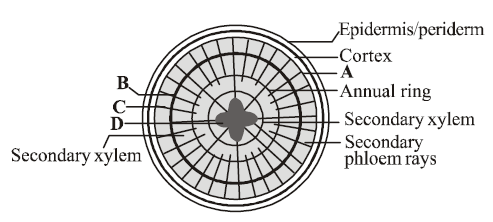
A Primary phloem, B Vascular cambium, C Secondary phloem, D Primary xylem
A Secondary phloem, B Vascular cambium, C Primary phloem, D Primary xylem
A Primary phloem, B Primary xylem, C Secondary phloem, D Vascular cambium
A Secondary phloem, B Primary xylem, C Primary phloem, D Vascular cambium
Tissue(s) present in an annual ring is/are
secondary xylem and phloem.
primary xylem and phloem.
secondary xylem only.
primary phloem and secondary xylem.
The vessel elements of angiosperms differ from other elements of xylem in having
simple pits on their radial walls.
bordered pits on their lateral walls.
simple and bordered pits on their end walls.
simple perforation on their end walls.
Apical, intercalary and lateral meristems are differentiated on the basis of
origin
function
position
development
Cambium is considered as a lateral meristem because
it gives rise to lateral branches.
it causes increase in girth.
it increases height and diameter of a plant.
it adds bulk to a plant.
Cork cambium and vascular cambium are
the parts of secondary xylem and phloem.
the parts of pericycle.
lateral meristems.
apical meristems.
Which one of the followings option shows the correct labelling of the parts marked as A, B, C and D in the given figure a lenticel?
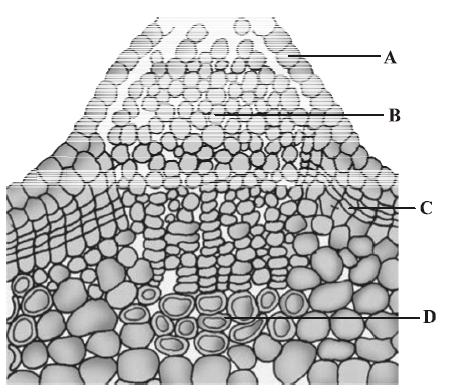
A Epidermis, B Secondary cortex, C Cork cambium, D Cork
A Pore, B Cork cambium, C Secondary cortex, D Cork
A Pore, B Cork, C Complimentary cells, D Cork cambium
A Epidermis, B Complimentary cells, C Cork cambium, D Secondary cortex
Gymnosperms are also called soft wood spermatophytes because they lack
cambium
phloem fibres
thick-walled tracheids
xylem fibres
An organised and differentiated cellular structure having cytoplasm but no nucleus is called _________.
vessels
xylem parenchyma
sieve tubes
tracheids
A common structural feature of vessel elements and sieve tube elements are
pores on lateral walls.
presence of p-protein.
enucleate condition.
thick secondary walls.
The length of different internodes in a culm of sugarcane is variable because of
size of leaf lamina at the node below each internode
intercalary meristem
shoot apical meristem
position of axillary buds
A narrow layer of thin walled cells found between phloem/ bark and wood of a dicot is
cork cambium
vascular cambium
endodermis
both (a) & (c)
Which of the following are present in monocot root ?
conjoint, collateral, open polyarch vascular bundle.
exodermis, endarch, tetrarch closed vascular bundles.
suberized exodermis, casparian strip, passage cells, cambium.
suberized exodermis, polyarch xylem, pith.
A tissue is a group of cells which are
similar in origin, but dissimilar in form and function.
dissimilar in origin, form and function.
dissimilar in origin, but similar in form and function.
similar in origin, form and function.
Xylem functions as a conducting tissue for water and minerals from _________to the ______and__________.
roots, stems, leaves
stems, roots, leaves
leaves, stems, roots
leaves, stems, leaves
The given figure shows T.S. of monocot stem. Identify the correct labelling of A to F marked in the given figure.
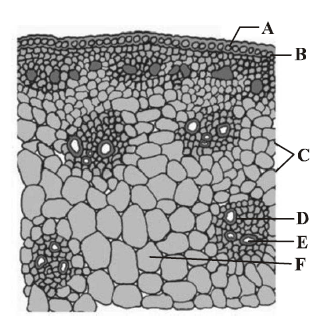
A Epidermis, B Hypodermis, C Vascular bundles, D Phloem, E Xylem, F Ground tissue
A Cuticle, B Epidermis, C Sclerenchymatous sheath, D Sclerenchymatous hypodermis, E Parenchymatous sheath, F Phloem
A Cuticle, B Epidermis, C Sclerenchymatous hypodermis, D Sclerenchymatous sheath, E Parenchymatous sheath, F Phloem
A Cuticle, B Epidermis, C Sclerenchymatous hypodermis, D Sclerenchymatous sheath, E Parenchymatous sheath, F Protoxylem
Match the elements of xylem given in column I with their character given in the column II and choose the correct option.
| Column-I | Column-II |
|---|---|
| A. Xylem vessels | I. Store food materials |
| B. Xylem tracheids | II. Obliterated lumen |
| C. Xylem fibres | III. Perforated plates |
| D. Xylem parenchyma | IV. Chisel-like ends |
A IV; B III; C II; D I
A III; B II; C I; D IV
A II; B I; C IV; D III
A III; B IV; C II; D I
Match column-I with column-II and choose the correct option.
| Column -I | Column -II |
|---|---|
| A. Bulliform cells | I. Initiation of lateral roots |
| B. Pericycle | II. Root |
| C. Endarch xylem | III. Grasses |
| D. Exarch xylem | IV. Dicot leaf |
| E. Bundle sheath cells | V. Stem |
A III, B V, C IV, D I, E II
A II, B V, C I, D III, E IV
A II, B IV, C I, D III, E V
A III, B I, C V, D II, E IV
Main function of lenticel is
transpiration
guttation
gaseous exchange
both (a) & (c)
The __________ occurs in layers below the epidermis in dicotyledonous plants.
parenchyma
sclerenchyma
collenchyma
aerenchyma
